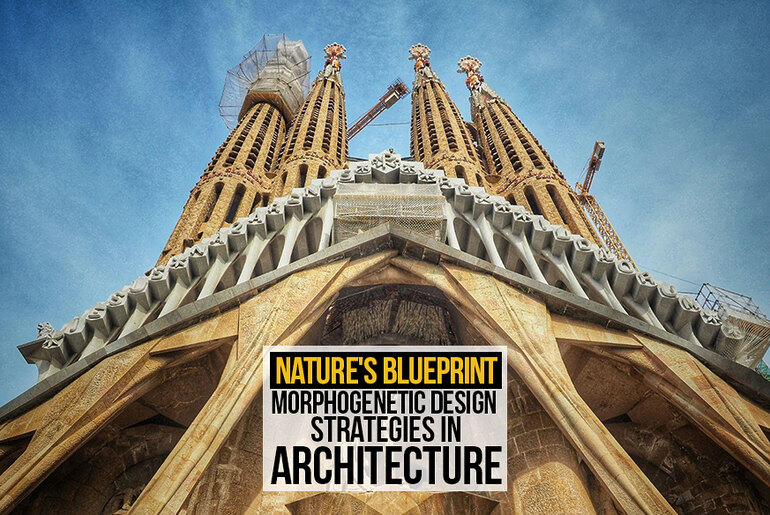The term “morphogenetic” originates from the Greek words “morphē,” and “genesis,” meaning form and creation. As the name suggests, in morphogenetic design, designers use techniques in form finding that draws inspiration from principles of morphogenesis in biology, which is the process of how living organisms develop their form and structure. It may be growth patterns, cell organization or material structure.

In the architectural world, this strategy of designing mainly includes using computational algorithms, parametric design, and generative processes to recreate or imitate the qualities found in nature.
Understanding Morphogenesis in Architecture
Architects employ generative design processes using computational algorithms to create various design iterations. These generative processes explore various possibilities, allowing architects to discover new solutions and forms that may not be immediately apparent through traditional design methods.
One of the main strategies used in morphogenetic design is the use of analogies between biological systems and architectural structures. For example, the branching patterns of trees and leaves, the complexities of coral formations, or the self-organizing behavior of ant colonies can serve as case studies.


The concept of “form follows function” is inherent in biological systems, where the morphology of an organism is closely tied to its specific functions and adaptive needs.This principle is embraced in morphogenetic design, where the form of a building is connected to its intended functions.
By understanding the principles determining these natural phenomena, architects can develop computational algorithms to replicate and adapt similar processes to provide solutions suitable for their designs.


Computational Algorithms
Use of computational algorithms is the main driving force behind morphogenetic design. These algorithms generate and simulate architectural forms depending on the constraints provided by the designer. These algorithms, often based on parametric and generative design principles, allow architects to create complex, adaptive, and responsive structures. This design strategy creates visually complex forms that might not have been conceivable through traditional architectural design methods.

The Role of Morphogenetic Design in Contemporary Architecture
One of the main impacts of morphogenetic design is the creation of unconventional, visually unique architectural forms. Abandoning rectilinear constraints of traditional design, architects can explore organic shapes, intricate patterns, and dynamic structures with curves and fluidity. This shift in the design generation process introduces new forms in architecture with the complexity and uniqueness found in nature.

Morphogenetic design holds sustainability in its DNA. It emphasizes adaptability to environmental conditions. This is a naturally evolving strategy in nature. Sustainable buildings are those that respond dynamically to changing climates, optimize energy usage, and integrate with surrounding ecosystems. These parameters are considered while generating forms through morphogenetic design processes.
Computational algorithms help generate multiple iterations as solutions suitable for the parameters we provide. This makes the design highly functional and environmentally conscious. For instance, buildings with flexible facades that adjust to sunlight showcase the functional adaptability inherent in morphogenetic design.

Case Study: Digital Grotesque

Digital Grotesque is a project by designers Michael Hansmeyer and Benjamin Dillenburger. It is a 3D printed room designed by using advanced computational algorithms to generate its intricate design. The process began with the creation of a digital model that incorporated parametric design principles inspired by natural forms. The algorithmic generation involved the simulation of growth patterns found in nature, resulting in a highly detailed and complex architectural structure. The end result is a 3D-printed room, featuring intricate details resembling natural organisms. This project challenges preconceived ideas of the form and function of manmade spaces.

The project showcased the promising potential of morphogenetic design in architecture by making use of computational design, 3D printing technology, and organic aesthetics.

What the future holds for Morphogenetic Design.
While morphogenetic design promises a visually stunning and functional future, designers face challenges in its practical applications. Technological limitations, material constraints, and construction complexities and funding can pose obstacles. The conversion of complex digital models into physical structures may require advancements in manufacturing techniques and construction methodologies.

Despite these doubts, morphogenetic design presents opportunities for innovative solutions. Advancements in 3D printing, robotic construction technologies, and materials offer potential solutions to ease real-life implementation problems. The continuous evolution of computational tools provides architects with increasingly easier methods to explore and realize morphogenetic designs. Generative design provides the best solutions in lesser time and will revolutionize design and construction in the coming future.
Morphogenetic design strategies in architecture represent an enchanting joining of nature’s evolutionary beauty and computational innovation. The exploration of biological analogies in design and the use of computational algorithms offer architects a unique opportunity to push the boundaries of design and break out of traditional form-finding techniques.
Morphogenesis in design showcases how nature-inspired principles can be harnessed to create visually stunning, functionally adaptive, and environmentally conscious architectural marvels.

























